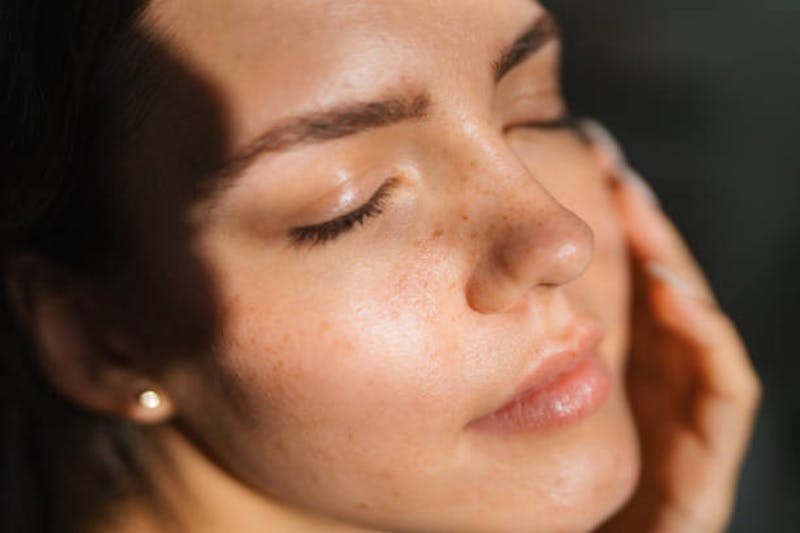
As a board-certified plastic surgeon with 33 years of experience treating patients in Scottsdale, I've witnessed countless transformations through both surgical and non-surgical approaches. Among the most rewarding aspects of my practice at Shapiro Aesthetic Plastic Surgery & Skin Klinic is helping patients achieve clearer, more even-toned skin through medical-grade treatments. Today, I want to share comprehensive insights about hydroquinone—a powerful topical agent that remains the gold standard for treating hyperpigmentation.
Hyperpigmentation affects millions of Americans, manifesting as dark spots, melasma patches, or post-inflammatory marks that can significantly impact self-confidence. While we offer advanced treatments like Morpheus8 and other energy-based devices at our facility, hydroquinone continues to play a crucial role in our comprehensive approach to skin rejuvenation. Understanding what to expect from hydroquinone treatment helps patients make informed decisions about their skincare journey, and those interested in the proper application techniques can explore further to maximize their treatment outcomes.
Understanding Hydroquinone Treatment Results
Through my years of practice, I've observed that patients who understand the science behind their treatments and maintain realistic expectations achieve the best outcomes. This article will explore hydroquinone's mechanism of action, typical results timeline, combination protocols, and important safety considerations that every patient should understand before beginning treatment.
Understanding How Hydroquinone Works
Hydroquinone functions as a tyrosinase inhibitor, blocking the enzyme responsible for melanin production in skin cells. This mechanism makes it particularly effective for treating various forms of hyperpigmentation, including melasma, age spots, and post-inflammatory hyperpigmentation from acne or injuries. Available in concentrations ranging from 2% (over-the-counter) to 4% (prescription), hydroquinone gradually lightens darkened areas by preventing new melanin formation while existing pigmented cells naturally shed through skin turnover.
The medication penetrates the epidermis to reach melanocytes—the cells producing pigment. By inhibiting tyrosinase activity, hydroquinone interrupts the conversion of tyrosine to melanin, effectively "turning off" excess pigment production in treated areas. This targeted approach allows normal-colored skin to remain unaffected while problematic dark spots gradually fade. For those seeking additional information about hydroquinone's effectiveness, this comprehensive guide provides valuable insights into treatment expectations.
In my practice, I typically prescribe 4% hydroquinone formulations for optimal results, often combined with tretinoin and mild corticosteroids in what we call "triple therapy." This combination enhances penetration, accelerates cell turnover, and minimizes potential irritation. The synergistic effect of these ingredients often produces superior outcomes compared to hydroquinone alone, and patients can learn more to understand how proper combination therapy maximizes treatment benefits.
Benefits of Professional Hydroquinone Treatment Results
It's important to understand that hydroquinone doesn't bleach existing pigment but rather prevents new pigment formation. This distinction explains why results develop gradually over weeks to months as pigmented cells naturally exfoliate and are replaced by normally pigmented cells. Patience and consistency prove essential for achieving desired outcomes.
Timeline of Visible Results
Based on my clinical experience treating hundreds of patients, hydroquinone typically produces initial improvements within 4-6 weeks of consistent use. However, significant results usually become apparent after 8-12 weeks of treatment. The timeline varies depending on several factors including pigmentation depth, skin type, sun exposure habits, and treatment adherence.
During the first month, patients often notice subtle lightning of treated areas. Some experience mild irritation or redness initially, which usually subsides as skin adjusts to the medication. I always emphasize during consultations that this adjustment period is normal and shouldn't discourage continued use unless severe irritation occurs. Those interested in visual documentation of treatment progress can view this detailed analysis showing real patient transformations.
Weeks 4-8 mark a critical phase where more noticeable improvements emerge. Dark spots begin fading more dramatically, and overall skin tone becomes more uniform. Patients frequently report increased confidence during this period as results become visible to others. Documenting progress through photographs helps patients appreciate gradual improvements that might otherwise go unnoticed, and those seeking additional guidance can read more for professional photography tips.
By week 12, most patients achieve 50-90% improvement in their hyperpigmentation. Complete resolution varies by condition—superficial age spots often clear entirely, while deeper melasma may require longer treatment or combination approaches. I typically recommend continuing treatment for 3-4 months before evaluating the need for maintenance therapy or alternative treatments.
Maximum results generally occur between months 3-6. After achieving desired improvement, I transition patients to maintenance protocols involving lower concentrations or intermittent use to prevent recurrence. This individualized approach helps sustain results while minimizing potential side effects from prolonged use.
Our Hydroquinone Treatment Results Process
Several variables influence hydroquinone effectiveness, and understanding these factors helps set realistic expectations. Skin type plays a significant role—patients with Fitzpatrick skin types III-V often require careful monitoring to prevent paradoxical hyperpigmentation or irritation. In my practice, I adjust protocols based on individual skin characteristics and response patterns, and patients can discover more to understand how personalized protocols enhance treatment safety.
Sun protection proves absolutely critical for treatment success. UV exposure stimulates melanin production, counteracting hydroquinone's effects and potentially worsening hyperpigmentation. I require all patients to commit to daily broad-spectrum sunscreen use with SPF 30 or higher, reapplying every two hours during outdoor activities. Physical barriers like wide-brimmed hats provide additional protection for facial melasma.
Consistency in application directly correlates with outcomes. Patients who apply hydroquinone twice daily as directed achieve significantly better results than those with sporadic use. I provide detailed written instructions and encourage patients to incorporate treatment into their daily routines, typically applying after cleansing and before moisturizer. For additional motivation, patients can view these expert insights showcasing real treatment transformations.
The depth and type of pigmentation also affect results. Epidermal hyperpigmentation (superficial) responds more readily than dermal pigmentation (deeper). Mixed-depth conditions like melasma often require combination treatments for optimal outcomes. During consultations at our Scottsdale facility, I use specialized imaging when necessary to assess pigmentation depth and customize treatment plans accordingly.
Concurrent skincare products and medications can enhance or interfere with hydroquinone effectiveness. I review each patient's complete skincare regimen and adjust as needed. Ingredients like vitamin C, kojic acid, and arbutin can complement hydroquinone, while certain products may cause excessive irritation when combined.
Why Choose Us for Hydroquinone Treatment Results
While hydroquinone has been used safely for decades, understanding potential side effects ensures optimal treatment experiences. Common initial reactions include mild redness, dryness, and stinging, particularly in patients with sensitive skin. These symptoms typically resolve within 2-3 weeks as tolerance develops. I often recommend starting with every-other-day application for sensitive patients before progressing to daily use, and those experiencing sensitivity can explore further for detailed guidance on managing initial reactions.
Ochronosis, a rare but serious side effect causing blue-black discoloration, can occur with prolonged high-concentration use, particularly in darker skin types. This risk underscores the importance of professional supervision and periodic treatment breaks. In my 29 years of practice, I've prevented this complication through careful patient selection, appropriate treatment duration, and regular monitoring.
Contact dermatitis affects approximately 5-10% of users, manifesting as persistent redness, itching, or swelling. When this occurs, I temporarily discontinue treatment and may prescribe mild topical steroids before attempting restart at lower concentrations or frequencies. Some patients require alternative lightening agents if true hydroquinone allergy exists.
The "hydroquinone holiday" concept involves periodic treatment breaks to minimize side effect risks and prevent tachyphylaxis (decreased effectiveness over time). I typically recommend 3-4 months of continuous use followed by a 1-2 month break, during which patients use alternative lightening agents like kojic acid or azelaic acid to maintain results.
Pregnancy and breastfeeding contraindicate hydroquinone use due to potential systemic absorption. I screen all female patients of childbearing age and recommend alternative treatments when appropriate. Post-pregnancy melasma often responds well to hydroquinone once breastfeeding concludes.
Getting Started with Hydroquinone Treatment Results
Frequently asked questions help address common inquiries about hydroquinone treatment.
How long does it take to see results from hydroquinone treatment?
Initial improvements typically appear within 4-6 weeks, with significant results visible by 8-12 weeks. Maximum improvement usually occurs between 3-6 months of consistent use. Individual results vary based on pigmentation type, depth, and adherence to treatment protocols.
Can hydroquinone permanently remove dark spots?
While hydroquinone effectively fades hyperpigmentation, results aren't always permanent. Melasma particularly tends to recur with sun exposure or hormonal changes. Maintenance therapy and vigilant sun protection help sustain improvements long-term. Some superficial age spots may resolve completely without recurrence.
Is it safe to use hydroquinone long-term?
Current recommendations suggest limiting continuous hydroquinone use to 3-4 months, followed by treatment breaks. This cycling approach minimizes risks like ochronosis while maintaining effectiveness. During breaks, alternative lightening agents help maintain results. Long-term safety requires professional monitoring and individualized protocols.
What should I do if hydroquinone irritates my skin?
Mild initial irritation often resolves as skin adapts. For persistent irritation, reduce application frequency to every other day or dilute with moisturizer. Severe reactions warrant discontinuation and medical evaluation. I often prescribe barrier repair creams or mild topical steroids to manage irritation while continuing treatment.
Can I use hydroquinone with other skincare products?
Hydroquinone combines well with certain ingredients like tretinoin, vitamin C, and niacinamide. However, avoid using with benzoyl peroxide, which can cause temporary skin discoloration. I provide detailed guidance on compatible products during consultations to optimize results while minimizing irritation.
How can I maintain results after stopping hydroquinone?
Maintenance strategies include daily sunscreen use, antioxidant serums, and alternative lightening agents like kojic acid or tranexamic acid. Some patients benefit from intermittent hydroquinone use (twice weekly) or annual treatment cycles. Customized maintenance plans prevent pigmentation recurrence while minimizing treatment risks.
Getting Started
At Shapiro Aesthetic Plastic Surgery & Skin Klinic, we combine medical expertise with personalized care to help patients achieve their aesthetic goals safely and effectively. Whether addressing hyperpigmentation through topical treatments like hydroquinone or exploring advanced options like our Morpheus8 technology, we prioritize patient education and realistic expectations. If you're considering hydroquinone treatment or other solutions for uneven skin tone, I encourage you to schedule a consultation at our Scottsdale facility. Together, we can develop a comprehensive treatment plan tailored to your unique needs and skin concerns.
____________________________________________________________________________
Board-Certified Plastic Surgeon, Shapiro Aesthetic Plastic Surgery & Skin Klinic


